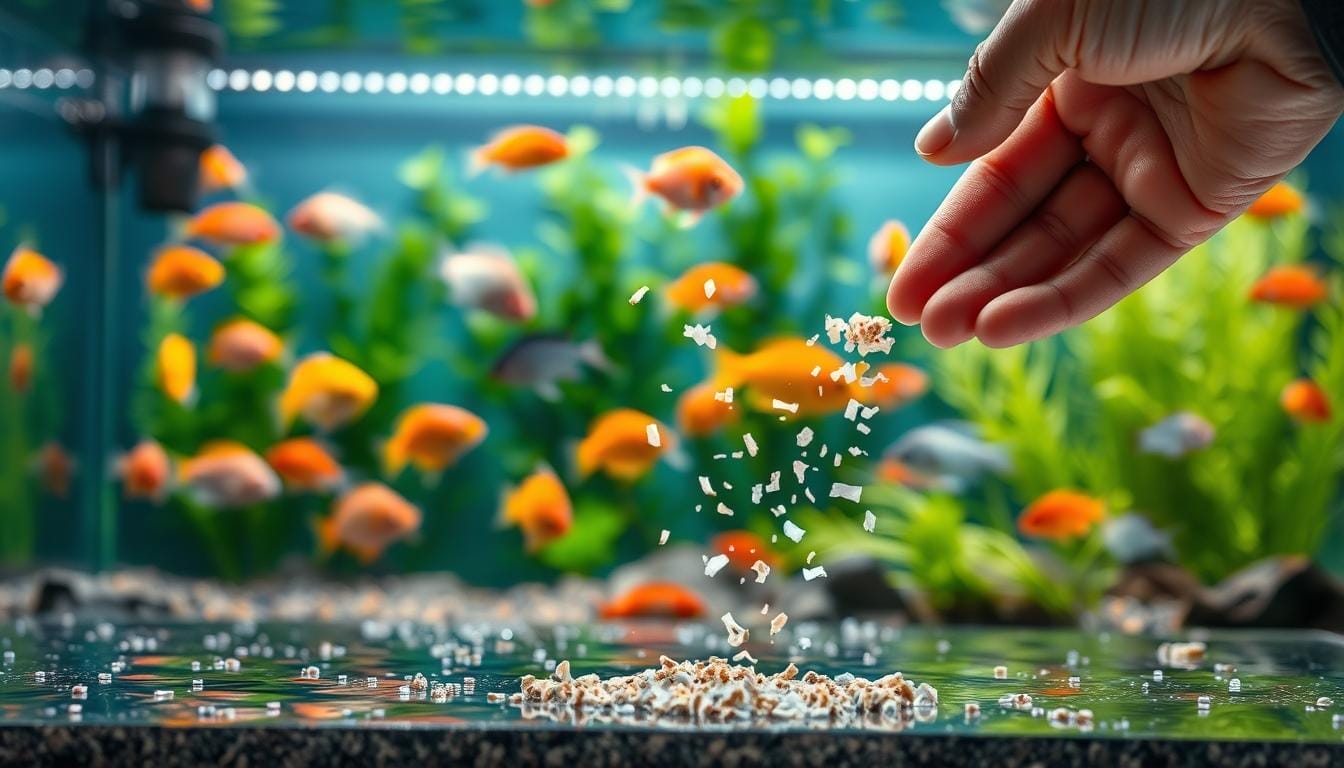
Discover the Best Small Aquarium Plants for Your Tank
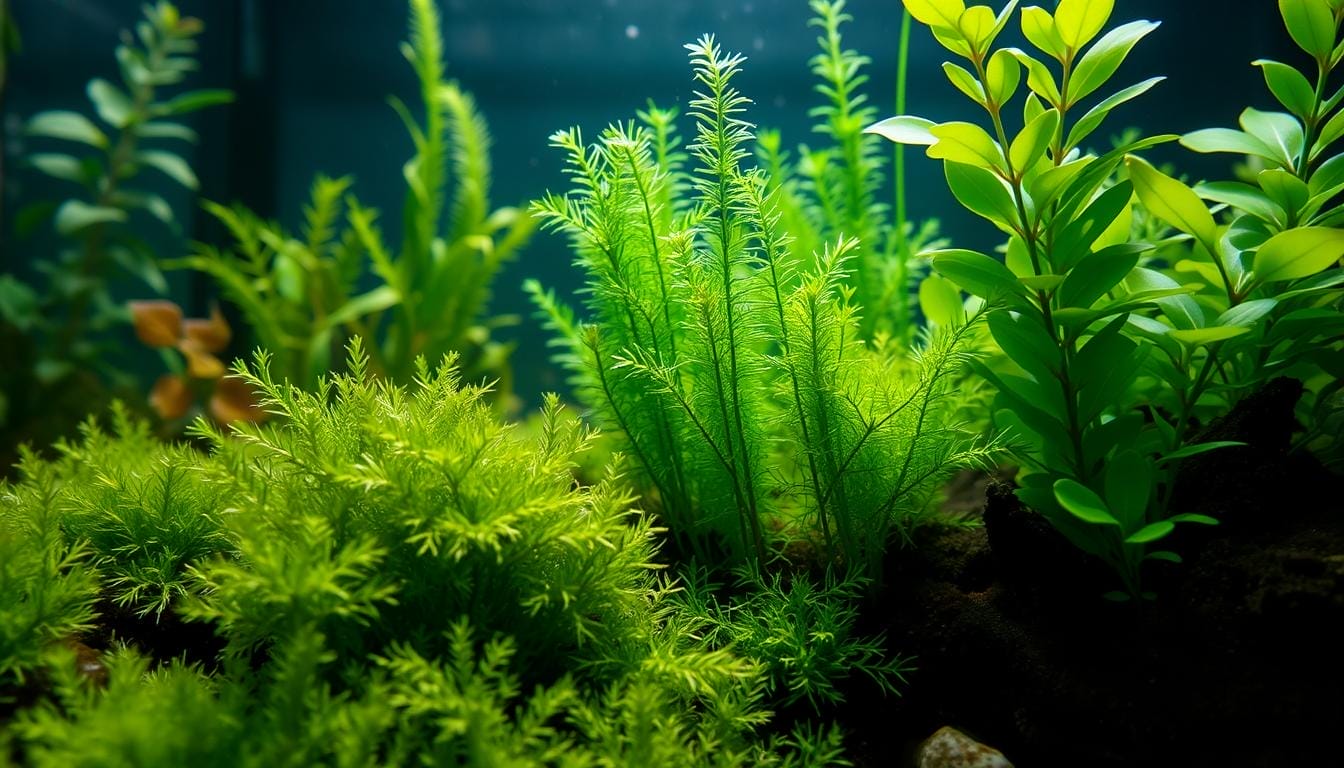
Did you know miniature underwater gardens can thrive without special equipment? Over 30 varieties of aquatic flora from trusted suppliers like Aquarzon adapt effortlessly to compact spaces. These tiny wonders let anyone create vibrant ecosystems, even in tanks smaller than a coffee mug.
Choosing the right greenery makes all the difference. Options like Anubias or Java Fern work beautifully in nano setups while serving as lush foreground accents in larger displays. Best of all, they grow happily under basic LED lights and don’t demand frequent water changes.
New to aquascaping? You’re not alone. Retailers like Buce Plant specialize in low-maintenance options perfect for first-timers. Prices start under $7, letting you experiment without stress. Even experienced hobbyists appreciate how these species simplify care while adding visual depth.
We’ll show you how to match species to your tank’s conditions. Light levels, water parameters, and fish compatibility matter – but don’t worry. With smart choices, your underwater scene stays healthy and eye-catching. Ready to transform your space?
Getting Started with Mini Aquascaping
Transforming your tank into a lush paradise is easier than you think. Forget complicated setups – low-tech approaches let you focus on creativity rather than equipment. This method works with what you already own, turning basic supplies into thriving ecosystems.
Understanding Low-Tech Requirements
True low-tech aquascaping means skipping CO2 systems and pricey gadgets. Most starter kits from stores like PetSmart include adequate LED lights for species like Java Moss. These hardy varieties grow steadily while filtering water naturally through their leaves and roots.
You’ll love how these species handle fluctuating conditions. They absorb nitrates from fish waste, reducing maintenance. Just use standard gravel or sand as your substrate – no special soils required.
Key Environmental Considerations
Three factors ensure success: ambient light exposure, stable temperatures, and weekly partial water changes. Position your tank where it gets indirect sunlight or 6-8 hours of artificial light daily. Test pH levels monthly with basic strips – ideal ranges sit between 6.5 and 7.5.
Already have fish? Perfect! Most community species coexist peacefully with aquatic greenery. Start with a single plant cluster and expand as confidence grows. Before long, you’ll craft scenes rivaling high-tech displays – without the stress or costs.
Why Choose Small Aquarium Plants for Compact Tanks
Imagine creating breathtaking underwater landscapes without needing a massive setup. These miniature marvels unlock creative potential through smart design choices. Their versatile nature makes them equally valuable for new hobbyists and seasoned designers.
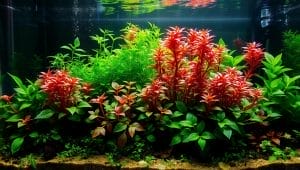
Growth Opportunities for Every Skill Level
Newcomers gain confidence through forgiving species that thrive in basic conditions. Species like Bucephalandra tolerate varying light levels and water parameters. Start with one variety, master its care, then expand your collection gradually.
Seasoned designers use these specimens to add intricate textures. Their delicate leaves create depth perception in nano displays. Attach them to dragon stone or spider wood using simple cotton thread – no glue required.
- Transform cramped spaces into layered vistas
- Experiment freely with layouts (no major costs)
- Provide safe zones for tiny aquatic creatures
These green wonders filter water naturally while serving as living decor. Maintenance becomes simpler since trimming needs decrease with slower growth rates. You’ll spend less time fussing and more time enjoying your aquatic masterpiece.
How to Choose & Care for small aquarium plants
Crafting a vibrant underwater scene starts with matching greenery to your setup. Focus on species that thrive in your existing conditions rather than chasing expensive upgrades. This approach keeps maintenance simple while letting your creativity flourish.
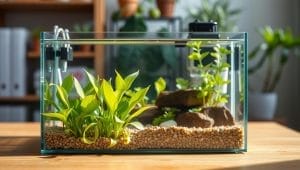
Essential Care Tips for Thriving Plants
Begin by observing your tank’s light levels. Most low tech varieties need just 6-8 hours of moderate brightness daily. Position taller species like Java Fern near the back to avoid shading smaller foreground specimens.
Nutrient delivery matters more than you might think. Use liquid fertilizers weekly for mosses and floating varieties. Root-feeding types benefit from tablets pressed into the substrate. Always keep Anubias rhizomes above ground – burying them leads to rot.
- Group stems in odd numbers for natural-looking clusters
- Trim yellowing leaves promptly to encourage new growth
- Test water parameters monthly using affordable strips
Healthy roots appear white or light-colored, while blackened ones signal trouble. New plants often shed older foliage while adapting – this normal process shouldn’t alarm you. With these basics mastered, your planted tank becomes a self-sustaining showcase of aquatic beauty.
Top Species for Unique Aquascapes
What separates ordinary tanks from showstopping aquascapes? The answer often lies in your choice of miniature foliage. These compact powerhouses transform ordinary layouts into living art while demanding minimal effort.
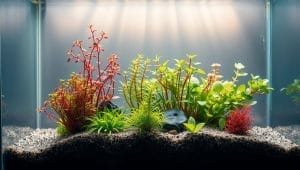
Anubias, Java Fern, and Other Mini Varieties
Anubias Nana Petite earns its “budget bucephalandra” nickname through dense clusters of coin-sized leaves. This slow-growing type thrives when attached to stones or driftwood, developing richer green hues under moderate light. At just 2-3 inches tall, it creates intricate textures without overcrowding your view.
Java Fern laughs at beginner mistakes. Its leathery leaves sprout baby plants from dark spore patches, multiplying your greenery over time. Unlike root-dependent species, it absorbs nutrients directly from water – perfect for tanks with basic substrates.
Crave contrast? Anubias Pinto and White varieties deliver striking marbled patterns. Their cream-and-green foliage pops against darker backgrounds, drawing the eye to key design zones. Attach them using fishing line or super glue gel – they’ll cling securely within weeks.
These champions survive fluctuating pH levels and irregular fertilization. You’ll appreciate their restrained growth, needing trims only every 3-4 months. Start with one specimen near your tank’s focal point, then expand as confidence grows. Before long, you’ll craft scenes that make fellow hobbyists ask, “How’d you do that?”
Designing Mesmerizing Foreground and Midground Planting
Your tank’s foreground and midground hold the secret to creating depth that draws viewers into your underwater world. These layers form the foundation of your design, guiding the eye while offering hiding spots for tiny inhabitants.
Carpeting Options: Monte Carlo vs. Pearl Weed
Monte Carlo creates lush green carpets resembling manicured lawns. Its tiny round leaves spread horizontally, forming dense mats perfect for foreground drama. This type thrives under moderate light and benefits from nutrient-rich substrate.
Pearl Weed offers versatility as both carpet and midground accent. Trim it short for ground cover or let stems grow vertically for bushy textures. This forgiving plant adapts to low-light setups, making it ideal for newcomers.
Key differences to consider:
- Light needs: Monte Carlo prefers brighter conditions
- Growth speed: Pearl Weed spreads faster with regular trimming
- Maintenance: Both types need monthly thinning
Attaching Plants to Driftwood and Rocks
Transform ordinary hardscape into living art with simple attachment methods. Use fishing line to secure Anubias rhizomes to porous lava rock. For quicker results, dab aquarium-safe glue on Java Fern roots before pressing them onto driftwood.
Position greenery at angles that mimic natural growth patterns. Stagger heights to create depth in your midground. Shrimp will appreciate the textured surfaces for grazing while adding movement to your view.
Remember to leave rhizomes exposed when attaching epiphytic varieties. Submerged roots eventually grip surfaces naturally, creating stable anchor points over 4-6 weeks.
Low Tech and Easy Care Aquarium Planting Solutions
Think you need fancy gear for a lush underwater garden? Low-tech setups prove vibrant ecosystems thrive through simplicity. These resilient species transform basic tanks into living art while handling beginner mistakes with grace.
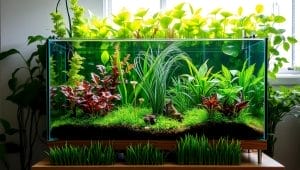
Anacharis leads the charge in effortless growth. Its feathery stems flourish under standard LED lights from Petco starter kits, absorbing fish waste as natural fertilizer. You’ll notice clearer water within days as this fast-grower devours excess nitrates.
What makes these options perfect for beginners? They turn potential problems into advantages. Uneaten food becomes plant nutrition instead of algae fuel. You skip CO2 injections and pricey substrates – your existing gravel works fine.
Three key benefits simplify your journey:
- Zero specialized equipment costs
- Natural water filtration through leafy surfaces
- Visual progress as stems multiply weekly
Start with floating Hornwort or rooted Amazon Sword. Both adapt to various tank sizes and light conditions. Trim freely to shape your layout – clippings root easily for instant propagation. Before long, you’ll craft intricate designs using nature’s simplest tools.
Diverse Plant Options for Every Tank Setup
Elevate your tank’s visual impact by looking up – floating species create dynamic surface landscapes that evolve daily. These surface dwellers offer dual benefits: stunning aesthetics and practical water management. Their trailing roots and leafy mats transform ordinary setups into layered ecosystems buzzing with life.
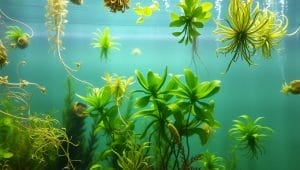
Surface Beauties With Hidden Talents
Red Root Floaters steal the show with fiery crimson roots that contrast brilliantly against green foliage below. This low-maintenance type thrives in standard LED lighting, multiplying rapidly to form natural sunshades. Shrimp adore grazing on their nutrient-rich tendrils while timid fish find shelter in the dense cover.
New hobbyists thrive with Salvinia Minima or Duckweed – these hardy survivors grow in virtually any condition. They devour excess nitrates, starving algae before it starts. Just scoop out handfuls weekly to control spread and compost extras responsibly.
Consider these factors when adding floaters:
- Bright tanks benefit from their light-diffusing magic
- Dim environments may need partial removal for submerged greenery
- Surface agitation should be minimal to prevent sinking
Watch your ecosystem flourish as these aerial wonders filter water and calm stressed inhabitants. Their ever-changing patterns keep your view fresh while simplifying maintenance – nature’s perfect multitaskers.
Expert Recommendations for Beginner-Friendly Aquascapes
Experts agree: success in aquascaping starts with forgiving plant species. Windy City Aquariums champions varieties that thrive under basic TopFin tank lights and standard equipment. Their curated list helps newcomers transition smoothly from plastic decor to living greenery.
You’ll appreciate these resilient types for their adaptability. Java Moss handles dim corners while Amazon Swords purify water in midground areas. Both grow in virtually any setup – no CO2 systems or specialized substrates needed.
Three starter favorites stand out:
- Anubias Nana: Attach to rocks for instant texture
- Cryptocoryne Wendtii: Adds color variations without demanding care
- Marimo Moss Balls: Roll them weekly for even growth
These options filter water naturally and adapt to common beginner mistakes. For detailed care tips, explore our beginner-friendly species guide. You’ll learn lighting basics, fertilization schedules, and how to avoid common pitfalls.
Start with these proven options to build confidence. Before long, you’ll craft views that captivate while keeping maintenance simple. Your planted tank journey begins here – let nature do the heavy lifting.
FAQ
Do small aquarium plants need CO2 systems to grow well?
Most compact species like Anubias Nana Petite or Java Fern thrive in low-tech setups without added CO2. Focus on consistent lighting and nutrient-rich substrates for steady growth.
How do I prevent algae in tanks with delicate foreground plants?
Balance light intensity (6–8 hours daily) and avoid overfeeding fish. Floating plants like Salvinia help filter excess nutrients, protecting carpeting species like Monte Carlo.
Can I attach plants directly to hardscape without substrate?
Yes! Use cotton thread or super glue gel to secure Bucephalandra or Java Fern to rocks or driftwood. Their roots will gradually anchor naturally.
Are there shrimp-safe options for nano aquascapes?
A> Pearl Weed and Anubias varieties work beautifully. They provide hiding spots without sharp edges, and their slow growth won’t trap debris harmful to shrimp.
What’s the easiest way to start a low-maintenance planted tank?
Begin with hardy species like Amazon Sword or Anubias Nana. Use root tabs for nutrients and opt for LED lights with adjustable brightness to match plant needs.
How often should I trim midground plants for visual balance?
A> Trim fast-growing stems like Pearl Weed every 2–3 weeks. For slower growers like Buce, occasional pruning (every 6–8 weeks) maintains shape without stressing the plant.





